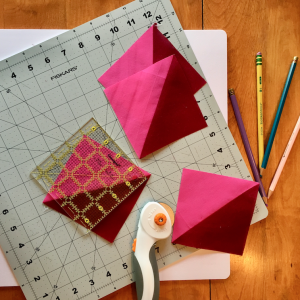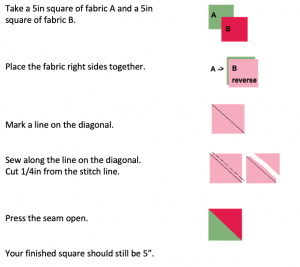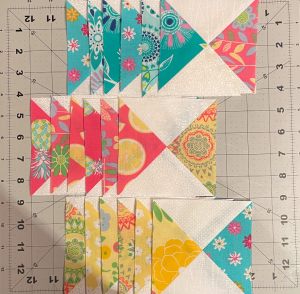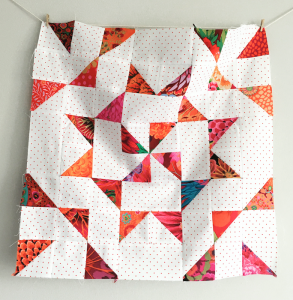In my last post I analyzed whether the design of a quilt top meets the statutory requirements for copyright protection and determined that it does. But there are still some unanswered questions. For example, if I wanted to create and sell a pattern with instructions on how to make my original quilt, would that also be protected under copyright law? And, if so, what might infringe?
The XYZ’s of Quilting
Quilting has its own vocabulary. Some of the basic terms were explained in Quilting and Copyrighting: Part 1, but let’s first review some of the basics. A Quilt block is a small design (usually square) which tends to show a distinct pattern. And a Quilt Top is the patchwork pretty side of the quilt, traditionally made up of multiple Quilt blocks.
Now let’s consider more advanced terminology that will be relevant to copyrightability of quilt pattern instructions. One term is Yardage. Yardage is the amount of fabric that you need to make a quilt. It is usually broken down by color (some quilts have specific use of color) or use (location on the quilt changes the amount of fabric needed drastically).
When sewing your fabric together, seam allowance is an important factor. First, just to be clear, a seam is the stitching that joins two pieces of fabric together. When you make a quilt each piece of fabric is sewn to the next one at a time. Seam allowance is the area between the stitching and the raw edge of the fabric. In quilting this usually measures a quarter inch. It is crucial to be precise with seam allowance because there are so many seams in a quilt. If your seams are too large you can lose a lot of fabric and reduce the size of the finished product by inches!

Next we have what is called a “half-square triangle.” A half square triangle is a commonly used mini-block. It is a square, made of two triangles sewn together along the hypotenuse (the longest side). When you sew two pieces of fabric together you put the right-sides-together. This means that you put the ‘pretty’ sides of the fabric facing each other. Then the seam is on the ‘inside’ and the pretty fabric is on the ‘outside’. The non-pretty side is called the reverse or the wrong side. Pressing is when you press the seam open with a hot iron so that the right sides are visible again and the seam lies flat.
Now that you know some of the key terms involved in quilting patterns, you have the vocabulary to understand whether patterns can be copyrightable and how.
Protecting Patterns
A commercial quilt pattern gives all the information necessary to make a quilt (although some knowledge of sewing and quilting generally is helpful). It begins by telling you what yardage is needed. It also often gives some advice as to color schemes or quilt specific quirks (like a ton of Y-seams). Then the pattern breaks down the individual blocks of a quilt seam by seam, often teaching tricks and shortcuts to commonly used blocks. This is done with a combination of text and illustrations or photographs. The pattern will tell you, step by step, how each piece of fabric combines into larger and larger sections until the quilt top is complete. Some patterns are easier to read than others and give helpful ‘beginner’ information like seam allowance and quilting and binding instructions.

As an example, a quilt pattern may look something like this:
Patterns of quilts are made so others can follow the instruction to make the same quilt. If I make my pattern, then I have written the instructions myself and drawn my own diagrams (like I did for the example above). But Is my pattern copyrightable?
For a work to be copyrighted it must be original to you, fixed in a tangible medium with at least minimal creativity, and not subject to any statutory bars (such as 102 or the useful article bar).
My pattern, which is made up of written instructions and diagrams, is original to me as I wrote and drew it myself. It is fixed in the tangible medium as it is printed on paper. And my pattern is likely more than minimally creative.
Why? Minimally creative is a pretty low bar, only the most obvious things like basic shapes or obvious alphabetization are unprotected. While one might argue that a quilt is just made of basic shapes like triangles and squares, the focus here are the instructions, not the quilt Because the pattern instructions involve a the combination of written and potentially visual explanations, the pattern is far more than minimally creative.

So, my pattern is both fixed in a tangible medium and likely minimally creative, but are there any statutory bars? Statutory bars prevent the copyrighting of useful articles (as I outlined in the last post) and they also prevent copyrighting of methods. The bar against copyright for methods is what’s potentially at issue with the instructions.
But I don’t think this bar is actually a problem here, I’ll explain why with an example. Imagine if I was the first person to make a peanut butter and jelly sandwich. So, I publish a book telling people how to make a PB&J complete with pictures and detailed instructions of how to spread the peanut butter and jelly onto the bread (and the ideal ratio of peanut butter to jelly). I have not copyrighted the method of spreading peanut butter and jelly since that is barred under the statute. I just have a copyright over my written instruction of how to make a PB&J, i.e. my word choice and how I chose to explain it.
Therefore, only the instructions and accompanying pictures in my pattern are copyrighted. There is no protection for the method. This means one cannot prevent others from teaching the method or using the instructions to make the same or even different quilts.
What violates the copyright?
To consider what violates the copyright, you have to look at the scope of copyright infringement, meaning how much and what is protected by copyright. Basically, the copyright owner has rights to exclude others from copying and even making ‘derivative’ works based on the original (i.e. a movie based on a book). These rights apply if the infringing material is substantially similar to the copyrighted work. It would be infringement, for example, if someone photocopied or scanned the pattern instructions as that is an identical copy – which far exceeds the standard of being substantially similar.
Copyright does not give the owner of the copyright in the pattern any ownership over quilts made using the pattern, only over the instructions on how to make the pattern.
However, someone who makes a quilt following my pattern is arguably infringing my copyright by creating an unauthorized copy. Unauthorized derivatives are also subject to a statutory bar. However, this bar only applies for unauthorized works that are not considered authorized as “fair use” which is subject to multiple factors that also consider if the work transforms the original. So, if they take my pattern and infuse their own style and voice so much that it becomes fair use, then they may have a copyrightable work.
Some people believe that, under Baker v. Selden, the copyright over instructions does not extend to the completed work (the finished quilt), but the law is not entirely clear. The Baker case was not about quilt instructions, but a method of bookkeeping. The case also focused on what was not copyrightable, the method of bookkeeping, rather than what was protected. And, as we just described above, quilt instructions or patterns are copyrightable.

So, what can you do with a quilt pattern? Some companies, such as Missouri Star Quilt Company, include a provision on their pattern that allow the quilt maker to do what they want with completed quilts (including selling them). But other pattern makers specifically request that the completed quilts are for personal use only. What if the pattern maker doesn’t specify what you can and cannot do with your completed quilt? You may be able to sell a quilt made with a commercial pattern, with no repercussions, but your best bet is reach out to the pattern maker if you’re not sure. If you are inspired by the instructions, but don’t actually follow them, and instead create a quilt that is substantially different from the intended quilt then you have likely not infringed.
Limits of Copyright Protection
Copyright protection also does not prevent patterns from being resold. The first sale doctrine grants those who purchase a copyrighted work the ability to sell, display or otherwise dispose of their particular copy. This means that the copyright holder is unable to limit what the purchaser does after the ‘first sale’ or the sale from the holder to the purchaser, subsequent sales are up to the purchaser. In this manner a quilter could purchase my pattern, make the quilt, and then sell or gift the pattern to another quilter (although the indy quilting industry would much prefer if your friend just bought their own $10 pattern). If the purchaser photocopies the pattern for a friend to use or, as PDF patterns are increasingly common, prints an extra copy, that would constitute infringement as it makes an unauthorized copy (as mentioned above).
So, while there are some copyright protections for quilts and their patterns and related sewn products, that protection is not expansive nor all encompassing. It is not always clear. In researching for this post, I came across many quilting blogs with misleading or just plain incorrect information. I hope some quilters will stumble across this post and have their fears assuaged. You are allowed to take inspiration from a quilt pattern! You are allowed to sell your pattern after completing the quilt! But don’t copy patterns – that’s copyright infringement!
I’ve linked some patterns below that that I really enjoyed making and some that are bucket-list quilts!
Exploding Heart by Slice of Pi Quilts
Wanderer’s Wife by Jen Kingwell
Antique Lace by Missouri Star
Missouri Star also has some free patterns available for download if you would like to take a look at a professional quilt pattern and maybe try your hand making one!
Lily Parker
Associate Blogger
Loyola University Chicago School of Law, J.D. 2022
Lily is a rising 3L at Loyola who decided to pursue law after a career in costume design, she (clearly) loves to sew and enjoys flexing her creative side.
